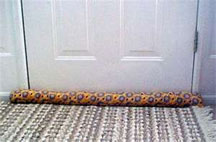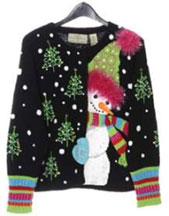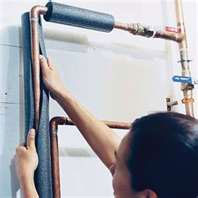Get Your Home Ready for Winter!
By Patty Liston
 In spite of all of my wishful thinking for summer to extend its warm life, the temperature around here dropped 15 degrees as of today. As you know, I do enjoy winter. It is just the cold and snow on the roads that I am not a fan of. Nonetheless, Old Man Winter will start bearing down on most of us soon, which means hot bread, warm soups, and preparing our homes for the cold that will come.
In spite of all of my wishful thinking for summer to extend its warm life, the temperature around here dropped 15 degrees as of today. As you know, I do enjoy winter. It is just the cold and snow on the roads that I am not a fan of. Nonetheless, Old Man Winter will start bearing down on most of us soon, which means hot bread, warm soups, and preparing our homes for the cold that will come.
Just as my hubby and I believe in wearing extra sweaters (see idea below) in order to keep ourselves warmer when temperatures drop, we also believe in putting a sweater around our home as well - figuratively speaking of course. We do this by following some of the examples given in "The Daily Green", as well as following some of our own family rules.
Most of these ideas are simple to implement and can save you quite a bit on those pesky utility bills. The US Department of Energy Replacing estimates that drafts can waste "5% to 30% of your energy use". Replacing old hot water heaters, drafty windows, etc., may cost you more, but there is a tax incentive. According to the American Council for an Energy-Efficient Economy:
 "The 2011 home improvement tax incentives will revert to the 2005-2008 levels: 10% of the cost of insulating, installing efficient windows, replacing old furnaces and air conditioners and making other home energy efficiency improvements. The incentive will be capped at $500, rather than $1,500, and anyone who has previously taken advantage of the program can't apply for incentives that exceed $500. (In other words, if you claimed $500 back in 2005 when you insulated your floors, or $1,500 in 2009 when you replaced windows, you have exhausted your tax credit; if you only claimed $300 in 2005, let's say, you can still claim $200, for a total of $500.)"
"The 2011 home improvement tax incentives will revert to the 2005-2008 levels: 10% of the cost of insulating, installing efficient windows, replacing old furnaces and air conditioners and making other home energy efficiency improvements. The incentive will be capped at $500, rather than $1,500, and anyone who has previously taken advantage of the program can't apply for incentives that exceed $500. (In other words, if you claimed $500 back in 2005 when you insulated your floors, or $1,500 in 2009 when you replaced windows, you have exhausted your tax credit; if you only claimed $300 in 2005, let's say, you can still claim $200, for a total of $500.)"
Here are some ideas that will help you put a "sweater" around your home.
 1. Roll up a towel and place it under a drafty door or window. Known as a "draft snake" during the Great Depression, these are the length of the bottom of your door or window, and go a long way to cutting out the cold. Or, you can make one by sewing a tube of heavy fabric the length of your door(s), filling it with sand or kitty litter for bulk, and voila! You may also purchase them in most home and discount stores.
1. Roll up a towel and place it under a drafty door or window. Known as a "draft snake" during the Great Depression, these are the length of the bottom of your door or window, and go a long way to cutting out the cold. Or, you can make one by sewing a tube of heavy fabric the length of your door(s), filling it with sand or kitty litter for bulk, and voila! You may also purchase them in most home and discount stores.
 2. Am I the only one who didn't know that ceiling fans have a reverse switch? Well, most of them do. Evidently, counterclockwise rotations produce cooling breezes while switching to clockwise makes it warmer: air pooled near the ceiling is circulated back into the living space, cutting heating costs by as much as 10%.
2. Am I the only one who didn't know that ceiling fans have a reverse switch? Well, most of them do. Evidently, counterclockwise rotations produce cooling breezes while switching to clockwise makes it warmer: air pooled near the ceiling is circulated back into the living space, cutting heating costs by as much as 10%.
 3. While many conventional water heaters are set to 140 degrees F by installers, most households don't need that much steam, and end up paying for it - in dollars and the occasional scalding burn. Lowering the temperature to 120 degrees F (or lower) would reduce your water heating costs by 6% to 10%.
3. While many conventional water heaters are set to 140 degrees F by installers, most households don't need that much steam, and end up paying for it - in dollars and the occasional scalding burn. Lowering the temperature to 120 degrees F (or lower) would reduce your water heating costs by 6% to 10%.
 4. Everything needs a tune-up, including your furnace. "Keep it clean, lubricated and properly adjusted will reduce energy use, saving up to 5% of heating costs." Most utilities offer a free annual "check-up" of your furnace. However, this service gets backed up as the winter months get closer. Make your appointment now. BEWARE! Make sure that the inspector is legitimate. Don't get talked into a furnace you don't need. Always get another opinion; preferably from someone you know personally.
4. Everything needs a tune-up, including your furnace. "Keep it clean, lubricated and properly adjusted will reduce energy use, saving up to 5% of heating costs." Most utilities offer a free annual "check-up" of your furnace. However, this service gets backed up as the winter months get closer. Make your appointment now. BEWARE! Make sure that the inspector is legitimate. Don't get talked into a furnace you don't need. Always get another opinion; preferably from someone you know personally.
 5. Wear a sweater! Heavy sweaters can add about 4 degrees of warmth to your body. (Who knew?) Wrap up in granny's quilt while you read. Get some wool socks. I've done all of this and more to keep myself warm and to avoid cranking up the heat.
5. Wear a sweater! Heavy sweaters can add about 4 degrees of warmth to your body. (Who knew?) Wrap up in granny's quilt while you read. Get some wool socks. I've done all of this and more to keep myself warm and to avoid cranking up the heat.
 6. Insulate your body. Insulate your pipes. This can decrease the chance of your pipes freezing - YIKES! If your pipes or hot water heater are warm to the touch, they may be perfect for adding some insulation. According to The Daily Green:
6. Insulate your body. Insulate your pipes. This can decrease the chance of your pipes freezing - YIKES! If your pipes or hot water heater are warm to the touch, they may be perfect for adding some insulation. According to The Daily Green:
You can get pre-slit pipe foam at most hardware stores. Cut it to size and fasten in place with duct tape. Ideally, choose the insulation with the highest R-value practical, which is a measure of its heat-blocking power. Pipe insulation is often R-3 or, for batt styles that you wrap around, a stronger R-7.
 7. It is suggested that we replace or clean our furnace filters once a month during the heating season. Dirty filters restrict airflow and increase our home's energy consumption.
7. It is suggested that we replace or clean our furnace filters once a month during the heating season. Dirty filters restrict airflow and increase our home's energy consumption.
If you have any great winterizing tips please let me know. Together, we will all be able to welcome Ol'Man Winter knowing that are homes are not only are toasty and warm but energy efficient as well.

Contribute to the Cook'n Club!
DVO would love to publish your article, prose, photography and art as well as your cooking, kitchen and nutrition tips, tricks and secrets. Visit the Newsletter Submission / Win Win for All section in our Forum for more information and details.
